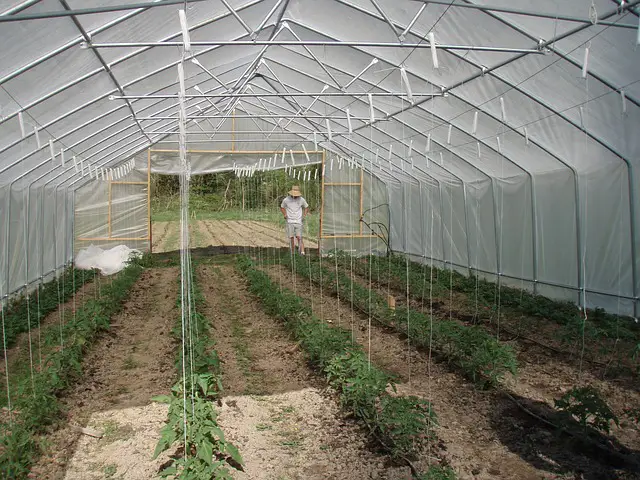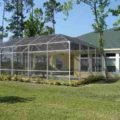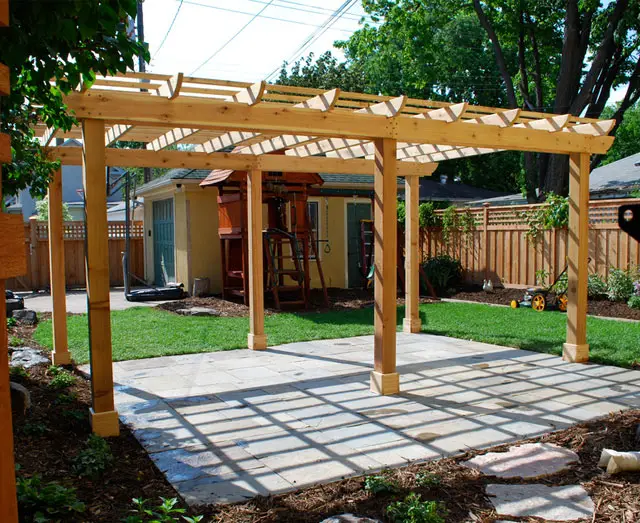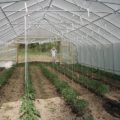Last Updated:April 25, 2024
Top Fruits and Vegetables to Grow in Greenhouse

This post is about the 13 easiest plants to grow in a green house. It will be helpful for people who want to start growing their own food at home, but don’t know where to begin. I’ll talk about how each plant should be grown and what it needs to thrive, as well as information on its growth cycle and other vital statistics. The goal of this post is for you find your next favorite green thumb project!
Cantaloupes
Cantaloupes are a great option for greenhouses. They are easy to grow and require very little work. Just be sure that they are kept about 50 cm (20 inches) away from other plants, as they can easily overtake them.
The climate should be warm— between at least 18° to 24°C (64° to 75°F). Nights must not go below 13°C (55°F).
Water them regularly to keep them growing, and fertilize every two weeks. Cantaloupes are self-pollinating, so you don’t need to worry about insects pollinating it for you. You can start picking when they are at full size—when the stem near the fruit cracks slightly when pressed with a finger. They are ripe when the fruit makes a sloshing sound when shaken.
Cantaloupes require fairly large plants at least 14″ wide and 16″ deep. They are also total water hogs that just soak up as much as they are given. It may be possible to overwater cantaloupes, but we never have.
Because so much of melons are water, they are very good at using excess rainfall or watering and turning it into fruit.
Green Onions
When I was young, green onions were one of the three plants that I was responsible for in our family garden. Green onions thrive in greenhouses and they are pretty resilient even just planted in the ground.
For us, they were almost like weeds to the point that if spilled some seeds in the garden, there was a high likelihood they would take root and just grow to maturity.
Green onions make the perfect beginner plant for aspiring gardeners. Also, they can be planted in small pots which work great for smaller children who want their own plants to help in the garden.
They are also a nice tasty treat that can be added to recipes. Unlike other produce, they have a wide window for harvesting so you don’t have to worry about wasting them by picking them too early or too late.
Carrots
Carrots are a very popular vegetable, and they are one of the easiest vegetables to grow in a greenhouse. They are planted any time of year even during the winter months. You just want to make sure the soil is loose so that they can grow down to reach their fullest potential even during the coldest months.
Carrots will take 2 to 4 months to grow from see to ready to harvest. Carrots do especially well in greenhouses since you can regular the water , and the pots keep the dirt more lose than if it were in the exposed ground.
Because they are root vegetable, the edible part is underground which make them much more resilient to temperature changes.
Turnips
We never raised turnips in our family garden. Some of our neighbors did, but they just were not a popular vegetable for us. I think my father ate a lot of turnips growing up, and he just really didn’t like them so they just weren’t something that we ever really talked about planting.
In a garden, there’s a limited amount of space and hours in the day that can be spent on the plants. Turnips are a nice cooler weather plant that can grow in greenhouses in the winter.
Turnips really like sun, and you will need a large deep pot. You will want to start the seeds in the larger pot as they don’t do well when moved.
Turnips are cool-weather greens that belong to the mustard family. They grow quite fast. You can savor both the roots and the greens. Another amazing fact about this vegetable is that they sprout in just a few days. This root crop is very nutritious and adaptable to most areas.
Spinach
Spinach is a good plant to grow especially in more moderate climates. Spinach is a leaf vegetable, and it can be grown at anytime of the year, although it normally best in late fall or early spring.
Spinach is very forgiving when it comes to how much light and shade it gets. It does like to get lots of water. Also, spinach really benefits from quality gardening mix or topsoil. The extra nutrients really help spinach thrive, but it will grow even without the extra nutrients in the soil.
Zucchini
Zucchinis are a great vegetable for greenhouses. They are especially item to grow as they can be eaten as a vegetable and as a fruit, depending on whether it is harvested before or after the flower blooms.
Zucchinis grow very quickly and reliably once planted into the soil. They will require at least six hours of sunlight per day to do well. There are many types of zucchini that vary in size and shape, so gardeners may want to pick a variety that would work best in their region.
Zucchini plants do not take up too much space, and they require little effort to maintain. A zucchini plant will produce fruit for about three months before it dies off. The biggest problem with zucchinis is that they tend to attract common garden pests, but otherwise they are a very dependable plant. This is one of the reason we like putting them in greenhouses since it will lower the number of insects that get to them.
Strawberries
Strawberries were a family favorite, but we never could get them to grow in our garden. I’m not sure if it was our soil or how we took care of them. We just never got a good harvest despite trying for many years.
Strawberries are hard to grow, but my aunt who lived a couple miles down the road with us had a decent crop every year. Fresh strawberries were her favorite food so it’s possible that she just devoted so much time and attention to make sure they grew.
Strawberries require very rich soil and regular watering. We do not recommend misters as that doesn’t seem to do as well. If you have a drip system, these are plants that you should definitely put on a shelf below a dripper.
If your greenhouse doesn’t have a drip system, you can user glass water bulb that can be filled with a large amount of water and will release it slowly overtime as the soil gets more dry.
I’ve included a link to the glass watering bulbs. We’ve been using these for years, and we love them.
- A THOUGHTFUL GARDENING GIFT: Incredibly efficient and dynamically practical, our gorgeous watering globes make the gardening chores of anyone with a green thumb, budding gardeners and even lifelong horticulturists easier and more enjoyable
- A thoughtful gardening gift: incredibly efficient and dynamically practical, our gorgeous watering globes make the gardening Chores of anyone with a green thumb, budding gardeners and even lifelong horticulturists easier and more enjoyable
- International products have separate terms, are sold from abroad and may differ from local products, including fit, age ratings, and language of product, labeling or instructions
- International products have separate terms, are sold from abroad and may differ from local products, including fit, age ratings, and language of product, labeling or instructions
Raspberries
Raspberries are a great alternative to strawberries if you are looking for a berry that is easier to grow. Raspberries flourish in the greenhouses, and they don’t require the high end soil.
If you want to grow raspberries in a greenhouse, we recommend you to buy a two year old bush. The bushes can be planted in pots or directly in the greenhouse floor from April until June. For the record, we don’t recommend planting anything in the ground under the greenhouse, but we did want to include it as an option.
Raspberry bushes can get pretty big going up to 6′ tall. By planting them in a 5 gallon pot, they can be moved outside the greenhouse once they become mature. The raspberry plants should have been pruned before they are moved. The best thing is to purchase a plant that was already pruned so you don’t have to worry about it when you get them home.
Cucumbers
Cucumbers are one of my mom’s favorite vegetables. While she’s cut back a lot of her gardening as she got older, cucumbers are one thing she insists on growing every year.
Cucumbers are very easy to grow and come from seeds. They are fairly hearty that don’t require a lot of upkeep. They also grow on vines that can grow up a trellis. This means they will take up very little shelf space. If you have a larger walk in greenhouse, you can put a cucumber trellis in the middle so that you can walk around it to access the other plants, but also benefit from the vertical in the middle of the greenhouse.
If you want to grow cucumbers in a greenhouse, we recommend getting a greenhouse that comes with cucumber trellises or making one out of some wood stakes and twine.
Cucumbers are pretty flexible when it comes to the amount of water and sunlight they get. Cucumbers like both and more is better as they just soak up water resulting in bigger fruits.
Cucumbers work best in pots that are wide rather then deep. A 20″ pot can hold between 5-6 cucumber plants. You can also put this planter at the base of a trellis, and when they start to grow help make sure the vines grow untangled up the trellis.
One important fact to remember about cucumbers is to harvest them regularly. When they get too big, they become bitter and just won’t taste good at all.
Kale
Kale is a great option for greenhouses because it helps purify the air. It is very easy to grow kale in a greenhouse, and it is praised by gardeners for its ornamental value as well as its usefulness.
Kale comes in many different varieties that are suited to all sorts of climates and locations, enabling users to pick the best type for their particular location. Kale is a super food that has become very popular in recent years due to all its nutritional value.
Kale makes a fantastic option to grown in a home garden because it is so expensive in the store. Kale is far more expensive per ounce than other leafy green vegetables, and it takes up less space than lettuce.
Kale also does well by harvesting some of the leaves of the plant at a time. This means that one head of kale can be pruned back every few days to get enough for a salad.
Peppers
Peppers are another fantastic plant to be grown in a greenhouse. They have a relatively long growing cycle, and they benefit from the increased growth window from the greenhouse.
Peppers come in many varieties between hot and sweet, and they work in a variety of temperatures. One key beauty of growing peppers is that there is almost always going to be an option that will thrive where you live.
Peppers need need a lot of space so we recommend putting them in a 12″ container. Some people have suggested putting 2 plants in a 5 gallon bucket, but we don’t recommend this. The two pepper plants will compete against each other for resources and one of them simply won’t do that well.
Instead, we’d recommend using a 2 gallon bucket for each of the two plants. Obviously, this is just a hack if you don’t have the ceramic planter pots.
Just as a side note, the best time to get ceramic planter pots is right in October. Retails stores like Walmart will be putting a lot of their gardening items on sale to free up room for Christmas decorations. You can often find pots at 25-50% off if you are patient.
It’s best to harvest peppers as soon as they get full-size. This is when they will have the best taste. Also, picking the fruit will lead to the plant producing more flowers which may result in more peppers.
Lemons
As we live in Arizona, we have lemon, orange, and papaya trees in our backyard. If we ever move to an area that we couldn’t have lemon and orange trees in our yard, we would definitely look at planting them in a greenhouse.
Our full size lemon tree is over 20′ tall and wouldn’t be appropriate for a greenhouse; however, there are dwarf lemon trees that only grow to 4′ tall. They can be nice for the center aisle of a walk in green house.
Between all the recipes that ask for lemon, lemon zest, there always seems to be a way for us to use them. Also, they are easy to process to save and freeze the lemon juice for year round.
Our one lemon tree produces more lemons than we could ever use in a year so we always end up giving our extras to our family and friends.
Oranges
Another fruit that is wonderful to grow in a greenhouse is oranges specifically Calamondin oranges. There are miniature orange trees that also grow to 4′. These dwarf orange trees are also very easy to grow that require little maintenance.
Also, it’s a wonderful treat to be able to grab some fresh squeeze orange juice with oranges that started their day on the tree. It tastes so much different than OJ from the store.
Wrapping up
So that’s our guide for the top 13 easiest to grow plant in a greenhouse. Do you have a greenhouse? If so, we’d love to hear your thoughts. Do you agree with us? Do you find something else easier? We’ve tried to balance vegetables and fruits that are perfect for beginners with ones that work for more experienced gardeners, but get much easier in a greenhouse than simply in the outdoors. Our community is mainly people who enjoy DIY projects around their home so for many of our readers, they have just completed their project of building a greenhouse, and they are looking for their ideas of the first things they should plant.






